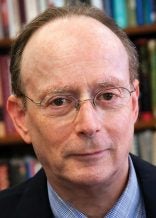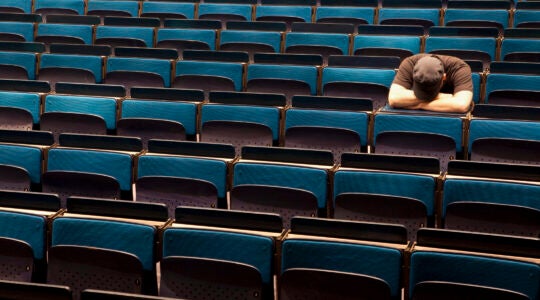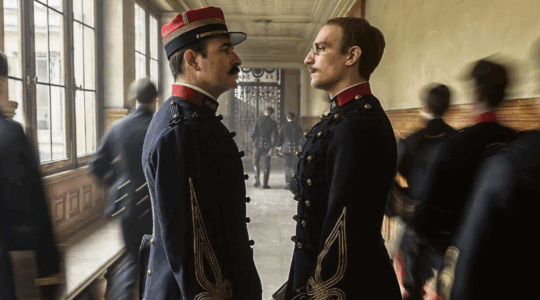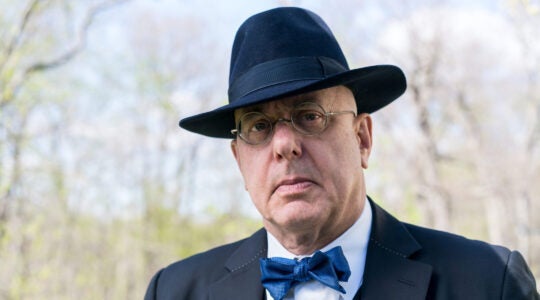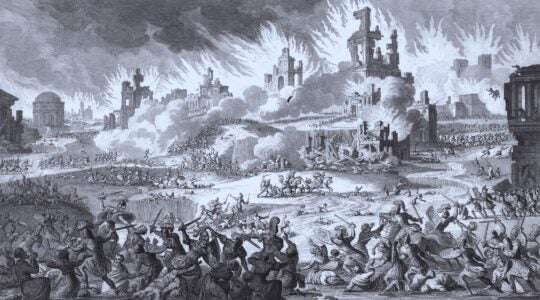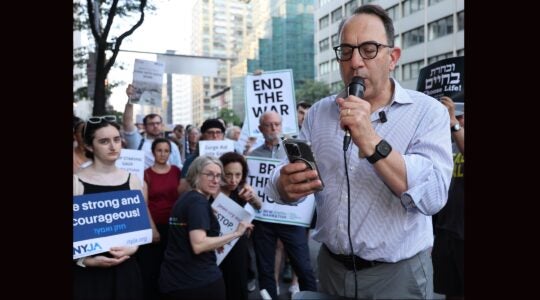Los Angeles — The 3-year-old boy stood on a chair in his backyard, and as about three dozen family members and friends gathered around, he led the assembled in a rousing, one-word-at-a-time call-and-response of the biblical verse: “Torah. Tziva. Lanu. Moshe. Morasha. Kehilat. Yakov.” (Moshe commanded the Torah to us, an eternal heritage for the congregation of Jacob.)
While his 10-day-old sister slept peacefully inside their house, the little boy — my grandson — then led us in the first six words of the Shema, followed by each of us taking turns snipping off a few locks of his long blonde tresses that, when not tied up in a bun, reached well past his shoulders. Seemingly oblivious to the scissor-action taking place behind him, the boy held a cupful of coins for tzedakah and carefully distributed one to each of us who approached.
Those were the key moments of his upsherin, or first haircut, in keeping with a tradition of letting a boy’s hair grow until he is 3, the age when he begins to wear a kipa and tzitzit and to learn Hebrew. The actual significance of the ceremony, which dates back to the 17th century, is a bit vague and appears to be more cultural than an actual mitzvah. It is commonly observed among chasidim but has become popular among others as well.
This particular event, which featured a rented Moon Bounce for the kids (and a few brave adults) as well as pizza and sweets, was a low-key ceremony, consistent with my impressions of much of Los Angeles Jewish life — creative, casual, relaxed — particularly compared to New York.
“New York is more bookish, more organically Jewish,” David Wolpe, author and rabbi of Los Angeles’ Sinai Temple, one of the largest and most successful Conservative congregations in the country, observed over coffee one morning. (Rabbi Wolpe writes the weekly “Musings” column for this paper.) “Jews came out here to succeed, not necessarily to make a Jewish life. But now you can do both.”
The rabbi has lived on both coasts and notes that L.A. “generates creativity,” with fewer boundaries of tradition than New York. In addition to Sinai Temple, with its Friday Night Live musical celebration of Shabbat, there are a number of trendy congregations and minyanim that emphasize ingenuity and feature rabbis with strong followings and national reputations. Several of the congregations are flourishing without permanent edifices. They include Sharon Brous of Ikar and Naomi Levy (who is married to L.A. Jewish Journal editor Rob Eshman) of Neshuva, two congregations that have drawn hundreds of unaffiliated Jews.
Rabbi Wolpe believes geography plays a key role in L.A.’s Jewish community, with Jews spread out all over the vast city; this results in vibrant but separate communities, often centered around the synagogue. “There’s not enough interaction among the various communities for us to have fights,” the rabbi mused.
Walking on Shabbat along Pico Boulevard between Robertson Boulevard and Beverly Drive — L.A.’s equivalent of the Miracle Jewish Mile, with its many ethnic synagogues, kosher eateries and supermarkets — one feels the pulse of traditional Jewish life. In most other areas of the city, though, there are few pedestrians altogether, a far cry from Manhattan’s Upper West Side, where one can hardly avoid running into Jewish contemporaries, which often leads to spirited, on-the-spot discussions.
Eshman stressed that transportation, or lack thereof, is not to be underestimated as a factor in L.A.’s communal dynamic. Since traffic is heavy and public transportation is minimal, people are wary of driving out of their neighborhoods to attend a Jewish event, he said. “Jewish L.A. is fragmented but vibrant. More people are finding new ways to express their Jewish identity” and seeking new forms of Jewish expression.
In the last several decades there has been significant growth among the Persian, Israeli and Russian communities of Los Angeles. No one seems to know their collective numbers — there hasn’t been a major Jewish population study of Los Angeles in many years — but it’s clear that those communities are growing in size, wealth and influence. Much of their generosity is directed toward Israel, and many of their members prefer to maintain their own infrastructures rather than take leadership roles in establishment groups like the local federation.
One dramatic change in L.A. Jewish life is the emergence of Hollywood Jews — those in the film and television industry — from the shadows. It is especially significant since their work influences the image of Jews around the world.
Danielle Berrin, who covers Hollywood for the Jewish Journal, told me that while Jews once sought to hide their identities and secularize their names, “there is a pride in being openly Jewish now. And writers are not afraid” to present scripts with strong Jewish characters and themes.
“Jewishness is everywhere,” she said. “It’s like a big coming-out party.”
On a personal level I wonder what it will be like for my two youngest grandchildren to grow up far from the East Coast, where our family has lived for the last century. The future holds endless possibilities. For now I pray that little Malka Nava Rosenblatt will embody the words her big brother, Moshe Kol, sang out the other day: “Morasha kehilat Yakov,” taking their place in the eternal heritage of Jacob.
The New York Jewish Week brings you the stories behind the headlines, keeping you connected to Jewish life in New York. Help sustain the reporting you trust by donating today.
